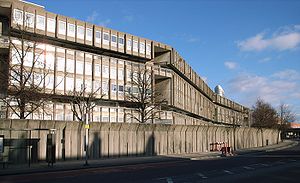| Robin Hood Gardens | |
|---|---|
 Robin Hood Gardens | |
 | |
| General information | |
| Location | Poplar, Tower Hamlets, London, England |
| Coordinates | 51°30′34″N 0°00′30″W / 51.50944°N 0.00843°W |
| Status | Western block demolished, East block under demolition |
| Construction | |
| Constructed | 1972 |
| Demolished | 2017–2018 (Western block) 2024-Present (Eastern block) [1] |
| Other information | |
| Governing body | Tower Hamlets |

Robin Hood Gardens is a residential estate in Poplar, London, designed in the late 1960s by architects Alison and Peter Smithson and completed in 1972. It was built as a council housing estate with homes spread across 'streets in the sky': social housing characterised by broad aerial walkways in long concrete blocks, much like the Park Hill estate in Sheffield; it was informed by, and a reaction against, Le Corbusier's Unité d'Habitation.[2] The estate was built by the Greater London Council,[3] but subsequently the London Borough of Tower Hamlets became the landlord.
The scheme, the first major housing scheme built by the Smithsons, consisted of two blocks, one of 10 and one of seven storeys, nurturing between them a large green; it embodied ideas first published in their failed attempt to win the contract to build the Golden Lane Estate in the City of London.[citation needed]
A redevelopment scheme, known as Blackwall Reach, involves the demolition of Robin Hood Gardens as part of a wider local regeneration project that was approved in 2012. An attempt supported by a number of notable architects to head off redevelopment by securing listed status for the estate was rejected by the government in 2009. The demolition of the western block began in December 2017. The eastern block, which is still inhabited by tenants, is to be demolished later. The site will contain 1,575 residences.[4]
Part of the building has been preserved by the Victoria and Albert Museum[5] and was presented at the Venice Architecture Biennale in 2018.[6]
- ^ =https://x.com/jon_cooper75/status/1814660791603191808?t=HOG6U7YWvMwHUWwySb48ww&s=19
- ^ Cite error: The named reference
mdFeb14was invoked but never defined (see the help page). - ^ "V&A · Robin Hood Gardens". Victoria and Albert Museum. Retrieved 12 November 2017.
- ^ Jessica Mairs, "Bulldozers move in on Robin Hood Gardens", Dezeen, 25 August 2017.
- ^ "V&A acquires a fragment of Brutalist architecture". IanVisits. 10 November 2017.
- ^ "'Ruins' of a London landmark resurrected in Venice". CNN Style. 23 May 2018. Retrieved 25 September 2018.